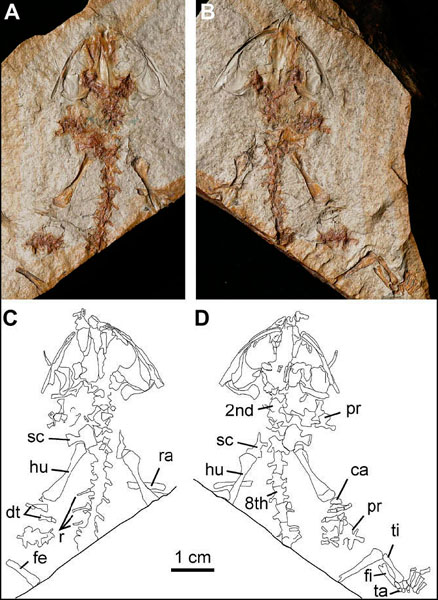Dr. Yuan Wang, Institute of Vertebrate Paleontology and Paleoanthropology, and his team recently described an Early Cretaceous salamander, Regalerpeton weichangensis gen. et sp. nov., from Weichang, Hebei Province, northeastern China. Their discoveries helped resolve highly controversial aspects of caudate phylogeny. This specimen is characterized by long, arched vomerine tooth rows running parallel to the maxillary arcade; a long and tapered anterior ramus of the pterygoid that curves anteromedially; an ossified hyobranchium with one pair of hypobranchials and two pairs of ceratobranchials; and scapulocoracoids with greatly expanded, approximately rectangular coracoid components. Phylogenic analysis places Regalerpeton as the sister group to a Cryptobranchidae clade including Chunerpeton, with Jeholotriton and Pangerpeton as successive sister taxa.

Photographs and line drawings of the holotype specimen (IVPPV14391) of Regalerpeton weichangensis (Wang et al)
The fossilbearing bed is in the second member of the Huajiying Formation, which overlies the Xiguayuan Formation and underlies the Nandian Formation in the Weichang Basin of northern Hebei (Wang et al., 1977). The deposits of the Huajiying Formation are mainly basic to intermediate lavas, inter-bedded by sedimentary layers of mudstone, siltstone, sandstone to conglomerate, with abundant tuffs. The Huajiying Formation in Hebei Province is regarded as a lateral equivalent of the Yixian Formation in Liaoning Province (Wang, 1999;Wang et al., 2000), and the latter has a well-accepted isotopic dating of 125 Ma (Swisher et al., 1999, 2002; Wang et al., 2000). Although invertebrate fossils (e.g., bivalves and conchostracans) are abundant in this formation, the salamander represents the first documented vertebrate from this formation, and the first from the Weichang Basin of Hebei Province.
The original paper was published in Cretaceous Research 30 (2009) 551–558.
|
